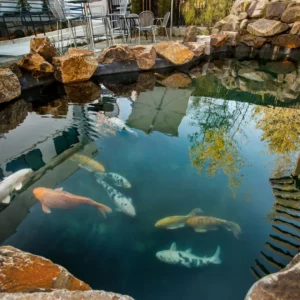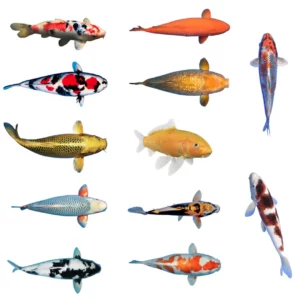The meaning of color in Koi fish goes beyond aesthetics, holding deep cultural and symbolic significance in Japanese tradition. Each color carries specific characteristics and resonates with different aspects of life.
Koi Fish Colors:
- serve as an important part of their unique appearance
- represent a distinguished marking that indicates the type/breed
- carry symbolism
- and even serve as a health indicator (due to possible coloration changes)
Let’s explore the most popular colors of these magnificent living artworks!
Koi Fish Colors: Table of Contents
Koi Fish Colors and Their Meaning
There are more than 100 types of Koi fish in the world, and they come in various colors and patterns. But some colors are more common than others.
Here are the most popular Koi fish colors and their meaning:
Hi (Red)
- Prosperity and Good Luck: Koi with large areas of red, like Kohaku, symbolize good fortune and abundant success.
- Love and Passion: Deeper shades of red can represent intense love and fiery passion.
- Strength and Courage: Red with black markings, like in Shusui Koi, can signify strength, determination, and overcoming challenges.
Fiery red, ranging from deep crimson to orange. Hi symbolizes good luck, vitality, and strength. It represents overcoming challenges and achieving success. Koi with dominant Hi markings are often seen as auspicious.
Shiro (White)
- Purity and Innocence: White Shiro Utsuri Koi symbolizes purity, innocence, and spiritual growth.
- Longevity and Good Health: It also represents longevity and good health, associated with wisdom and experience.
- Success and Fulfillment: White patches on Kohaku signify achievement and fulfillment in one’s chosen field.
Pure white, sometimes with a pearly sheen. Shiro embodies purity, innocence, and good fortune. It also signifies longevity, wisdom, and new beginnings. White Koi are often associated with peace and tranquility.
Sumi (Black)
- Mystery and Transformation: Black Showa Sanshoku Koi embodies mystery, transformation, and resilience.
- Knowledge and Power: Deeper blacks are associated with power, knowledge, and hidden potential.
- Balance and Protection: Black markings provide contrast and balance, sometimes representing protection and grounding energy.
Sometimes have metallic undertones. Sumi represents parental love, protection, and mystery. It can also symbolize overcoming adversity and inner strength. Black Koi are often seen as guardians and protectors.
Ki (Yellow) Koi
- Wealth and Prosperity: Golden yellows and oranges of Goshiki Koi symbolize wealth, prosperity, and financial abundance.
- Ambition and Drive: It represents ambition, drive, and the potential to achieve great things.
- Optimism and Happiness: Lighter yellows evoke optimism, happiness, and a sunny disposition.
Koi enthusiasts call them “goldfish” or “golden Koi’’. These fish symbolize wealth, prosperity, and ambition in Japanese culture. Some believe owning a Ki Koi brings financial success and material abundance.
Kiwa (Metallic/Gray) Koi
- Luxury and Refinement: Ginrin Koi’s shimmering scales signify luxury, refinement, and exclusivity.
- Transformation and Potential: The metallic sheen represents the potential for transformation and achieving a higher state of being.
- Luck and Success: It’s sometimes associated with fortune and success.
This color is characterized by metallic scales that shimmer with silver, platinum, or even gold, representing refinement, sophistication, and a life well-lived. Kiwa Koi are often associated with luxury and elegance.
Matsuba (Green) Koi
Symbolizes growth, renewal, and good health. They represent vitality, resilience, and the constant cycle of life. Owning a Matsuba Koi is believed to bring good health and longevity.
Soragoi (Sky Blue)
Symbolizes tranquility, peace, and masculinity. The sky-blue scales evoke calmness and inner peace.
Koi Fish Color Combinations
Some Koi fish also come in a combination of different colors, making these Koi fish varieties even more beautiful and distinguished.
Here are some of the best examples:
Kohaku (White and Red)
- Name Meaning: Kohaku translates to “amber” or “red lacquer,” referencing the vivid red markings on the white base.
- Symbolism: Kohaku is considered the “King of Koi” and embodies good luck, fortune, prosperity, and a strong life force. The red represents passion, energy, and success, while the white signifies purity, innocence, and longevity.
- Choosing the high-quality one: Red markings should be bold, deep red without orange bleed or mottling. Look for an even distribution, with clear margins between red and white areas. It should also have minimal (or no) red patches on the head and fins.
White has to be pure, crisp white without blemishes or yellowing. Pearlescent sheen is a bonus. Smooth, even distribution complementary to the red pattern.
Sanshoku (Three-Color)
- Name Meaning: Sanshoku means “three colors,” usually referring to white (Shiro), red (Hi), and black (Sumi).
- Symbolism: The three colors combine the meanings of each individual hue. Red signifies good luck and prosperity, black represents strength and resilience, and white symbolizes purity and wisdom. Altogether, Sanshoku Koi represents balance, harmony, and overcoming challenges.
- Choosing the high-quality one: Red must have the same vibrant, even characteristics as high-quality Kohaku red.
Black should be deep and glossy with a metallic sheen. Sharp, well-defined edges to the markings, particularly on the head and fins. It needs even distribution, often in a net-like pattern over white or complementary to red patterns.
Just like Kohaku, white needs to have pure, sharp characteristics.
Goshiki (Five-Color)
- Name Meaning: Goshiki translates to “five colors,” typically white (Shiro), red (Hi), black (Sumi), blue (Konjo), and light blue (Akebi).
- Symbolism: Goshiki Koi are considered highly auspicious, representing abundance, harmony, and the five elements of nature (earth, water, fire, metal, and wood). The combination of colors symbolizes balance, good fortune, and a fulfilling life.
- Choosing the high-quality one: The red, white, and black markings should be the same high-quality ones as mentioned for Sanshoku. The blue and light blue colors have to be clear, vibrant hues with subtle metallic sheen.
Shusui (Mirror Scaled)
- Name Meaning: Shusui translates to “water of spring,” referencing the glistening, metallic scales covering the fish’s body.
- Symbolism: Shusui Koi are known for their reflective beauty and are associated with wealth, prosperity, and perseverance. The metallic sheen is believed to ward off evil and attract good luck.
- Choosing the high-quality one: This one must have a bright, shimmering metallic sheen that reflects multiple colors like silver, gold, and blue. Even distribution over the entire body is another mandatory characteristic.
Yamabuki Ogon (Golden Yellow)
- Name Meaning: Yamabuki translates to “Japanese Kerria” (a yellow flower), while Ogon means “gold.”
- Symbolism: Yamabuki Ogon Koi symbolizes wealth, power, and vitality. The vibrant yellow hue represents sunshine, optimism, and success in business ventures.
- Choosing the high-quality one: A high-quality Yamabuki Koi should have rich, vibrant yellow without orange or white patches. It should have even distribution and smooth transitions across the body. The metallic sheen that reflects colors is a bonus.
How to Distinguish a High-Quality Koi Based on Its Colors?
You can tell a Koi fish is high-quality if it has strong and distinct colors in its pattern(s).
Here are some examples:
- ‘’Hi’’ (red)
- High-quality: Bold, deep red without orange bleeding or mottling. Even distribution across the body, ideally with clear margins between Hi and Shiro areas. Minimal Hi patches on the head and fins are desired.
- Low quality: Faded, patchy red, bleeding into Shiro or orange. Uneven distribution, with large Hi patches on the head or fins.
- ‘’Shiro’’ (White)
- High-quality: Pure, crisp white without blemishes or yellowing. Pearlescent sheen is a bonus. Smooth, even distribution across the body, complementary to the Hi pattern.
- Lower quality: Yellowish or milky white, with patches of color bleed or imperfections. Uneven distribution, with large blank areas or blotchy patterns.
- Sumi (Black)
- High-quality: Deep, glossy black with a metallic sheen. Sharp, well-defined edges to the markings, particularly on the head and fins. Even distribution, often in a net-like pattern over Shiro or complementary to Hi patterns.
- Lower quality: Faded, dull black with blurry edges or patchy distribution. Brownish tinge or bleeding into other colors.
- Ki (Yellow)
- High-quality: Rich, vibrant yellow without orange or white bleeding. Even distribution and smooth transitions between Ki and Shiro areas. Metallic sheen preferred.
- Lower quality: Pale, dull yellow with orange or white patches. Uneven distribution, with blotchy patterns or large blank areas.
- Kiwa (Metallic/Gray)
- High-quality: Bright, shimmering metallic sheen that reflects multiple colors like silver, blue, and green. Even distribution across the body, often appearing as a subtle overlay on other colors.
- Lower-quality: Dull, muted sheen with a single dominant color like gray or bronze. Uneven distribution, patchy or concentrated in specific areas.
- Matsuba (Green)
- High-quality: Deep, grassy green with a hint of blue or yellow iridescence. Even distribution is often layered over Shiro or with subtle Kiwa highlights.
- Low-quality: Pale, muddy green with brown or yellow tones. Uneven distribution, concentrated in patches or blotchy patterns.
- Soragoi (Sky Blue)
- High-quality: Clear, vibrant sky blue with a hint of silver or white sheen. Even distribution across the body, often with subtle Kiwa highlights.
- Low-quality: Pale, milky blue with grayish or greenish tones. Uneven distribution, concentrated in patches or blotchy patterns.
Other Ways to Distinguish a High-Quality Koi
Here are some additional characteristics that can help you distinguish a high-quality Koi:
- The fish’s colors should be evenly distributed over its body and free from any other pigmentation unless it forms another pattern.
- The patterns should be well-defined and should not blend into the background color. Each Koi is unique, and each variety has its own pattern parameters.
- The markings should be well-balanced throughout the fish’s body – the pattern must be balanced (evenly distributed) from side to side and from front to back.
- Scales typically don’t impact the overall quality of a Koi unless they’re absent. On the other hand, they can indicate the type of Koi based on their pattern – full scalation, partial scalation (armor scale), or no scaleless (‘’Doitsu’’ in Japanese).
What Do Color Changes in Koi Fish Mean?
Colors are a great way to categorize types of Koi fish, but their colors can often change. Although it’s often normal for some Koi to change their colors over time, the changes in coloration can have several meanings.
I made a quick breakdown to help you understand these changes better.
Ontogenetic Color Change
This natural process alters the intensity and sometimes the pattern of a Koi’s colors as it matures.
For example, a young yellow Koi might darken to a deeper orange over time. This change is generally predictable within specific varieties.
Environmental Factors
Here are some of the environmental factors that can cause changes in Koi fish colors:
Water quality: Hard water can intensify blacks and dull whites, while softer water might do the opposite.
Sunlight exposure: While a Koi’s colors can be enhanced by basking in the sun, excessive exposure can result in sunburn, leading to discoloration.
Pro tip: To prevent sunburn, you should check out different Koi fish pond ideas and how to protect it from direct sunlight.
Diet quality: A balanced Koi fish diet, rich in vital, healthy nutrients, can enhance the vibrancy of their colors over time.
Pro tip: You can also influence the coloration of your Koi fish by providing them with color-specific diets. These diets contain supplements like carotene and spirulina, and it is recommended to feed them once daily.
However, note that no drastic improvements are guaranteed, and you should always consult an experienced fish vet.
Sickness and Stress
Sudden or drastic color changes can sometimes indicate stress or illness in Koi. For example, fading colors, patchy patterns, or even the appearance of new colors (like streaks of black) can be warning signs.
Observing other behaviors and water parameters and providing adequate care, is critical to determine the cause and take appropriate action.
Breeding
Some Koi breeds are specifically bred for dramatic color changes, like Kohaku (white with red markings) which develop deeper red patterns as they mature. In these cases, the changes are intentional and benefit the aesthetics of the fish and its value.
My Senior Paws is a participant in the Amazon Services LLC Associates Program, an affiliate advertising program designed to provide a means for sites to earn advertising fees by advertising and linking to Amazon.com. We also participate in other affiliate programs which compensate us for referring traffic.




